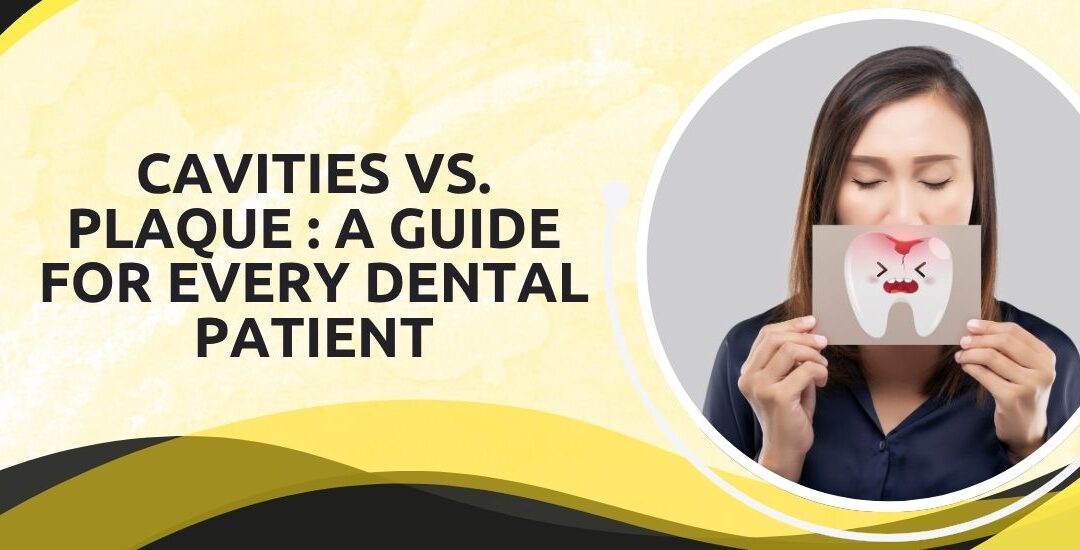Cavities vs Plaque: What Every Dental Patient Should Know
We often underestimate how much our oral health impacts our overall well-being. Many people brush twice daily but still end up visiting the dentist with tooth pain or sensitivity. And that’s why understanding the root causes of dental problems—especially cavities vs plaque—is more important than merely maintaining a routine.
According to global data by the World Health Organization (WHO), nearly 3.5 billion people worldwide are affected by oral diseases, with tooth decay ranking as one of the most common. In India alone, dental caries affect around 60–65% of the population, while plaque-induced gum issues impact more than 80% of adults.
Dr. Jahnavi Patel, an accomplished Dental Expert at Dentafix Dental Clinic in South Bopal, Ahmedabad, explains:

“Most dental issues don’t start overnight. Cavities and plaque build up gradually, often due to small daily habits we overlook—like skipping flossing or consuming excessive sugary drinks. When patients understand how these conditions develop, prevention becomes far easier and more effective.”
Ready to understand what your teeth are actually trying to tell you? Let’s begin with decoding the signs behind cavities
Cavities - Symptoms and Signs
Cavities—also known as dental caries—are areas of tooth decay that occur when bacteria produce acid that erodes enamel. Early detection is vital because cavities can progress from mild sensitivity to severe pain and infection.

Here’s how to recognize them early:
Tooth Sensitivity: If you feel a sharp sting when sipping a hot or cold drink, it might be an early sign of enamel breakdown.
Visible Holes or Spots: Cavities often begin as white spots but can darken into brown or black pits on the surface of the tooth.
Persistent Toothache: Pain without an obvious cause could signal deeper decay affecting the tooth nerve.
Bad Breath or Unpleasant Taste: Bacteria thriving in decayed areas release odors, causing bad breath that brushing alone can’t fix.
Discomfort While Chewing: Pain during chewing, even with soft foods, might indicate advanced decay that needs prompt dental care.
Dr. Jahnavi Patel, a compassionate dentist in South Bopal, Ahmedabad, says:
“When cavities reach the dentin or pulp layer, discomfort becomes constant. I often advise patients—don’t wait until the pain dictates your visit. The earlier you act, the simpler the treatment.”
Next, let’s explore how plaque — an equally silent troublemaker, sneaks up on your teeth.
Plaque - Symptoms and Signs
Plaque is a sticky, colorless film of bacteria that constantly forms on your teeth. It may seem harmless at first, but if left untreated, it hardens into tartar, paving the way for gum disease and tooth decay.

Common signs of plaque accumulation include:
A Sticky Feeling on Teeth: That fuzzy sensation after skipping brushing? It’s plaque starting to cling.
Bleeding Gums: When gums bleed during brushing or flossing, it’s a red flag that bacteria have started irritating gum tissues.
Persistent Bad Breath: Plaque bacteria produce sulfur compounds that cause unpleasant odors.
Yellowish or Dull Teeth: Plaque buildup can mask the natural whiteness of teeth, making them appear stained.
Dr. Devhuti Hariyani, an insightful dental professional in South Bopal, Ahmedabad, explains:
“Plaque is the foundation of almost every dental problem. Once it calcifies into tartar, it can’t be removed by brushing alone. That’s when professional cleaning becomes essential to restore oral health.”
Now that you know how both conditions show up — let’s uncover what exactly sets cavities apart from plaque.
Cavities and Plaque: Key Differences
Understanding the distinction between cavities vs plaque can help you take targeted action for your oral health. Here’s a simple breakdown:
|
Aspect |
Plaque |
Cavities |
|
What it is |
A sticky film of bacteria forming on teeth |
Permanent tooth damage caused by bacterial acids |
|
Stage |
Early, reversible stage of oral disease |
Later, irreversible stage requiring treatment |
|
Effect |
Irritates gums and causes tartar build-up |
Destroys enamel, dentin, and pulp |
|
Treatment |
Removed by professional cleaning |
Needs filling, root canal, or restoration |
|
Prevention |
Brushing, flossing, and routine cleanings |
Avoiding sugar, maintaining oral hygiene |
Dr. Riya Rathi, an experienced root canal specialist in South Bopal, Ahmedabad, emphasizes:
“Plaque is like the seed, and cavities are the fruit. Stop plaque early, and you prevent cavities altogether. Prevention is truly the most painless form of dental care.”
Prevention always sounds easier said than done—but it’s absolutely achievable with the right steps. Here’s how to stay ahead of plaque and cavities.
Preventing Cavities and Plaque Build-Up
Preventing dental issues isn’t about perfection—it’s about consistency. Here’s how you can keep your teeth healthy and strong:
Brush Twice Daily: Use a fluoride toothpaste and soft-bristled brush. Brushing for two minutes effectively removes daily plaque.
Floss Regularly: Flossing reaches between teeth where a toothbrush can’t, removing hidden food particles.
Eat a Balanced Diet: Limit sugary foods and drinks. Opt for crunchy fruits and vegetables—they naturally clean teeth surfaces.
Rinse After Meals: A simple water rinse after eating can minimize acid buildup.
Regular Dental Check-ups: Professional cleanings every six months help remove plaque before it turns into tartar.
Use Antibacterial Mouthwash: It helps reduce bacteria levels, protecting gums and enamel alike.
Dr. Jahnavi Patel, a dedicated Dental Surgeon in South Bopal, Ahmedabad, adds:
“Your daily routine is your first line of defense. But pairing it with periodic dental cleanings ensures comprehensive care that even the best home routines can’t replace.”
Even with good habits, it’s not always easy to know when to seek professional help. Let’s find out the signs that tell you it’s time to book that dental appointment.
When to Visit Your Dentist

You don’t have to wait for pain to signal trouble. Regular check-ups help detect issues before they escalate.
- Consider visiting your dentist if you notice:
- Persistent bad breath or bleeding gums
- Sensitivity to temperature or sweets
- Visible discoloration or holes in teeth
- Pain when biting or chewing
- Swollen or tender gums
Dr. Jahnavi Patel, an attentive dentist in South Bopal, Ahmedabad, advises:
“Prevention is powerful, but early intervention saves smiles. Visiting your dentist every six months ensures your oral health stays on track, and small problems don’t become big ones.”
Conclusion
Cavities and plaque may sound simple, but they can drastically impact your oral health if ignored. While plaque represents the beginning of bacterial buildup, cavities mark irreversible damage. By understanding the difference between cavities vs plaque, you empower yourself to act early and maintain a confident, pain-free smile.
Still have a few questions lingering? Let’s clear them up below.
Frequently Asked Questions:
1. Can plaque turn into cavities?
Yes. If plaque isn’t removed, it hardens into tartar and produces acids that eventually erode enamel, leading to cavities.
2. How often should I get a professional cleaning?
Ideally, every six months. However, those prone to gum issues or decay may benefit from quarterly cleanings.
3. Can diet influence plaque and cavity formation?
Absolutely! Frequent sugar intake encourages bacterial growth. A diet rich in fiber, calcium, and water helps combat plaque naturally.
4. Are cavities reversible?
Early-stage enamel weakening can be reversed with fluoride, but once a cavity forms, professional treatment is required.
5. Why do some people get cavities easily despite good hygiene?
Genetics, saliva composition, enamel strength, and dietary habits all play roles. Regular dental visits help manage these factors effectively.
References:
https://my.clevelandclinic.org/health/diseases/10946-cavities
https://en.wikipedia.org/wiki/Dental_plaque
Disclaimer: The information shared in this content is for educational purposes only and not for promotional use.





